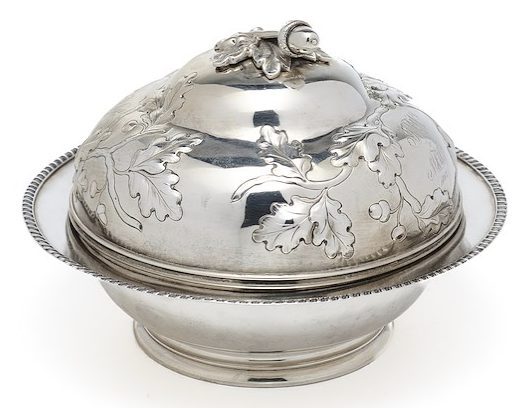 |
| Butter cooler, Vincent Laforme, Boston, c.1850 Collection of Gibson House Museum |
The maker of the dish was prominent Boston silversmith Vincent Laforme; the gothic “L” and eagle hallmarks stamped on the underside are his marks. Laforme was the son and brother of silversmiths. Born in Germany in 1823, he and his family moved to Boston in 1833 where his father trained him and his brothers in silversmithing. A decade later, Vincent set up his own shop at 5 Water Street where he worked with his brother Francis—their business name was Laforme and Brother. In 1854 the name was changed to F.J. Laforme & Co. after the brothers parted from the company, but three years later the business went out of operation. During Vincent’s time at the company, the Laformes would wholesale their products to larger companies including Lincoln & Foss. Vincent continued to work as a silversmith where he was cited as a good craftsman but a poor manager.
Before refrigeration, butter coolers prevented butter from melting during warmer weather and when sitting out for long periods of time. Ice or water would be placed inside the butter cooler to preserve the butter. (For longer-term storage without refrigerators, storing butter could be as simple as placing it underneath Irish peat or under layers of cloth.) James H. Stimpson registered one of the earliest patents for a butter cooler on May 15th, 1855 in Baltimore. In his patent papers he states, “An important advantage of my ‘butter cooler’ is, the keeping of the butter effectually cool and hard in hot weather, without putting ice on the butter.” In addition, the dome cover keeps the butter free from insects.
Whether on the table or the sideboard, there would be a knife beside the butter cooler that was used only for serving butter. Guests would not use their own knives for butter, as it was considered poor manners. Later in the nineteenth century, there would occasionally be a small glass or ceramic plate meant for butter that was set for every member of the table. These are commonly known as “butter pats.” (The Gibson House Museum has a set of butter pats in its collection.)
In the 19th century, butter was expensive, in part due to its perishability. Butter was typically made by rural women in their homes where they would then sell their products to city grocers who sold to families like the Gibsons. After 1861, butter was primarily made in factories in the United States through a process called “creamery production.” In both methods, butter needed to be transported to consumers, using some method of cooling. (Mechanically refrigerated transport, via train or truck, did not take off until the 20th century.)
This silver butter cooler allows visitors to see 19th-century methods of food storage, while also displaying the artisan silver work of the period. These luxury items were a status symbol representing the wealth of families like the Gibsons and their peers. The Gibson House Museum is pleased to share this new acquisition with visitors.
Before refrigeration, butter coolers prevented butter from melting during warmer weather and when sitting out for long periods of time. Ice or water would be placed inside the butter cooler to preserve the butter. (For longer-term storage without refrigerators, storing butter could be as simple as placing it underneath Irish peat or under layers of cloth.) James H. Stimpson registered one of the earliest patents for a butter cooler on May 15th, 1855 in Baltimore. In his patent papers he states, “An important advantage of my ‘butter cooler’ is, the keeping of the butter effectually cool and hard in hot weather, without putting ice on the butter.” In addition, the dome cover keeps the butter free from insects.
Whether on the table or the sideboard, there would be a knife beside the butter cooler that was used only for serving butter. Guests would not use their own knives for butter, as it was considered poor manners. Later in the nineteenth century, there would occasionally be a small glass or ceramic plate meant for butter that was set for every member of the table. These are commonly known as “butter pats.” (The Gibson House Museum has a set of butter pats in its collection.)
In the 19th century, butter was expensive, in part due to its perishability. Butter was typically made by rural women in their homes where they would then sell their products to city grocers who sold to families like the Gibsons. After 1861, butter was primarily made in factories in the United States through a process called “creamery production.” In both methods, butter needed to be transported to consumers, using some method of cooling. (Mechanically refrigerated transport, via train or truck, did not take off until the 20th century.)
This silver butter cooler allows visitors to see 19th-century methods of food storage, while also displaying the artisan silver work of the period. These luxury items were a status symbol representing the wealth of families like the Gibsons and their peers. The Gibson House Museum is pleased to share this new acquisition with visitors.
- Francesca Caron, Simmons University (Curatorial Intern, Spring 2025)
To learn more:
- MFA Collections: Pitcher
- Rainwater, Dorothy T., and H. Ivan Rainwater. American Silverplate. Schiffer Publishing, Limited, 1988.
- The Winterthur Library, Joseph Downs Collection of Manuscripts and Printed Ephemera


No comments:
Post a Comment